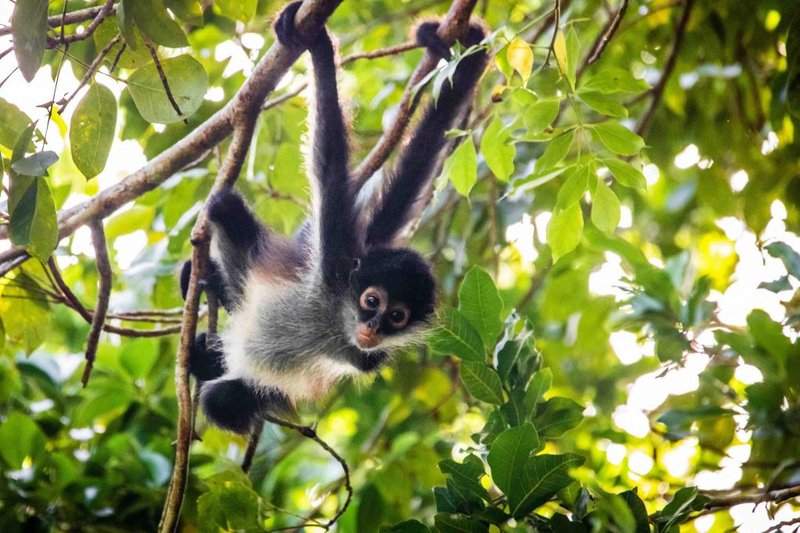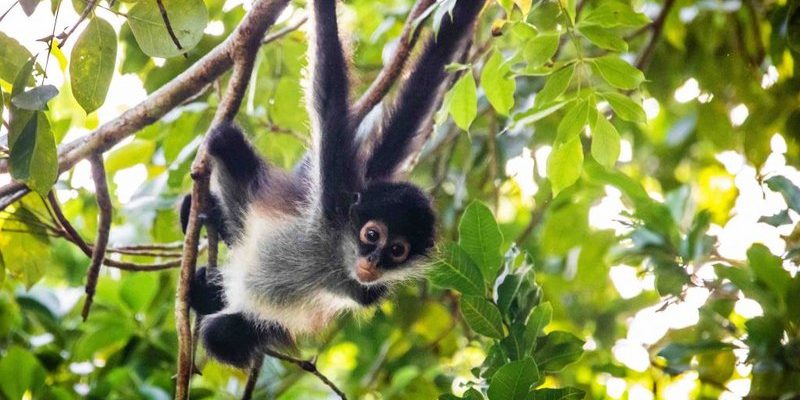
Imagine for a moment that the jungle is a bustling city, with spider monkeys as the delivery drivers. They zip around, gathering and redistributing seeds, thus ensuring a vibrant plant life that supports countless other species. Their acrobatics and social behaviors not only make them entertaining but are essential to the balance of the tropical rainforests they inhabit. Let’s dive deeper into understanding the spider monkey’s ecosystem role, their behaviors, and why we should care about their conservation.
What Makes Spider Monkeys Unique?
Spider monkeys belong to the Atelidae family and are primarily found in Central and South American forests. Their unique features set them apart from other monkeys. With long, slender limbs and prehensile tails, they are master climbers. Their tails function almost like an extra hand, allowing them to navigate the canopy with remarkable agility.
These monkeys are social animals, often found in groups known as troops. They communicate through various vocalizations, ranging from squeaks to howls, which can be heard echoing through the forest. Their social structure is complex and plays a vital role in their survival. For example, they often cooperate in foraging for food, making it easier to find the fruits, seeds, and leaves they thrive on.
You might be wondering how these characteristics tie into their ecosystem role. Well, working together means they’re more efficient at finding food, which helps maintain the health of the forests they inhabit. Their foraging habits help with seed dispersion, indirectly promoting forest growth—vital for countless other species.
Seed Dispersers: Nature’s Gardeners
One of the most significant roles spider monkeys play in their ecosystem is that of seed dispersers. When spider monkeys eat fruits, they often do not fully digest the seeds. Instead, these seeds make their way through the monkeys’ digestive systems and are later dropped in a new location, often miles away from where they were consumed.
This process is crucial for forest regeneration. By moving seeds around, spider monkeys help different plant species spread, ensuring biodiversity in their habitat. Imagine planting a garden where each plant grows to its fullest potential thanks to caring gardeners. Spider monkeys essentially perform that role on a much larger scale.
Additionally, by dispersing seeds, spider monkeys contribute to the resilience of their environment. A diverse forest can better withstand diseases and climate changes, creating a healthier habitat for all species, including humans. So, when you see a spider monkey swinging through the treetops, remember they’re not just having fun—they’re working hard to keep their home thriving.
The Link Between Spider Monkeys and Other Species
Spider monkeys are not just important for plants; they also support various animal species in their ecosystem. By helping to create and maintain a healthy forest, they provide habitats for countless creatures, from insects to birds and other mammals.
For instance, the fruits that spider monkeys eat attract a variety of birds and smaller animals. This abundance of food keeps populations thriving and helps maintain the intricate web of life in the rainforest. If spider monkeys were to vanish, it could create a ripple effect, threatening the survival of many animal species that depend on the plants they help cultivate.
Furthermore, their presence can indicate the overall health of their environment. Ecosystems with spider monkeys are often more robust and diverse. Thus, conservation efforts aimed at protecting spider monkeys can indirectly benefit many other species. It’s like ensuring the roots of a tree are strong—if the roots are healthy, the rest of the tree flourishes.
Threats to Spider Monkeys and Their Ecosystem
Sadly, spider monkeys face numerous threats that jeopardize their survival and, subsequently, their role in the ecosystem. Habitat loss due to deforestation is one of the main issues. As forests are cleared for agriculture, logging, and urban development, spider monkeys lose their homes and food sources.
Additionally, hunting and poaching pose severe threats. In some areas, spider monkeys are hunted for their meat or captured for the illegal pet trade. These activities further decrease their populations and disrupt the balance of their ecosystems.
The decline of spider monkey populations also impacts overall forest health. Without these key players, we risk losing not only the monkeys themselves but also the vibrant biodiversity they support. It’s a sobering thought that our actions can affect so many lives in the jungle.
Conservation Efforts: What Can We Do?
Conservation efforts are key to protecting spider monkeys and their habitats. Supporting organizations dedicated to rainforest preservation can make a difference. Many groups work on reforestation projects, which help restore habitats for spider monkeys and countless other species.
You can also advocate for sustainable practices in your local communities. This might involve supporting eco-friendly products, reducing waste, or even educating others about the importance of biodiversity. Every little action counts—think of it like planting a small seed that can grow into something magnificent.
Additionally, raising awareness about the plight of spider monkeys can encourage others to take action. Social media is a powerful tool for spreading information. Sharing compelling stories or facts about these amazing creatures can inspire people to care about their survival.
The Importance of Ecosystem Balance
The health of our planet relies heavily on ecosystem balance, and spider monkeys are crucial in maintaining that balance. By facilitating seed dispersal and supporting biodiversity, they help create a thriving environment that benefits countless other species, including humans.
When we think about the bigger picture, it’s essential to recognize that every creature plays a role, no matter how small. The loss of spider monkeys could mean the loss of our forests too. They serve as a reminder that we are all interconnected, and caring for one species can have far-reaching impacts.
To sum it up, protecting spider monkeys isn’t just about saving them; it’s about preserving the intricate web of life that sustains us all. So, the next time you hear about spider monkeys, remember their vital role in the ecosystem and consider how you can help ensure their survival.
In conclusion, spider monkeys are not just fascinating creatures swinging through the trees; they are essential to the health of their ecosystems. By understanding their role and the threats they face, we can take steps to protect them and the vibrant forests they inhabit. Ultimately, it’s about embracing our responsibility to the natural world and fostering a future where all beings can thrive together.

